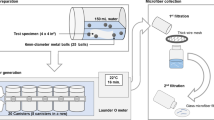Abstract
A pilot study was conducted to estimate fungal spore penetration for wall service outlets subjected to a constant air pressure. During the laboratory experiment, a wall chamber was fabricated, and telephone, electrical, and cable service outlets were installed. Penicillium chrysogenum spores were aerosolized into the chamber that was held under pressure. Spores that penetrated the outlets were funneled into an impinger for microscopic enumeration. Thirty trials were conducted for each of the five outlets (N = 150), and the wall chamber was decontaminated between trials. Results of an analysis of variance suggest wall service outlets allow spore penetration. The penetration factor for the telephone outlet was significantly greater than all other outlets (p < 0.05), and there was no difference in penetration between electrical outlets with and without plugs. Penetration factor differences were attributed to air leakage rates across the outlets. Due to the experimental design and equipment limitations, further research is needed to support these findings.
Similar content being viewed by others
References
Airaksinen, M., Kurnitski, J., Pasannen, P., & Seppanen, O. (2003). Fungal spore transport through a building structure. Indoor Air, 14, 92–104.
Aizenberg, V., Reponen, T., Grinshpun, S. A. & Willeke, K. (2000). Performance of air-o-cell, burkard, and button samplers for total enumeration of airborne spores. American Industrial Hygiene Association Journal, 61, 855–864.
Alvine, G. F., Rodgers, P., Fitzsimmons, K. M., & Ahrens, R. C. (1994). Disposable jet nebulizers: How reliable are they. Chest, 101, 316–319.
American Optical (1974). AO Spencer bright line hemacytometer. Buffalo, NY: American Optical Company.
American Thoracic Society (1997). American thoracic society workshop, achieving healthy indoor air. American Journal of Respiratory and Critical Care Medicine, 3, 534–564.
Buttner, M., Cruz-Perez, P., Stetzenbach, L. D. & Garrett, P. J. (1999). Dispersal of fungal spores from three types of air handling system duct material. Aerobiologia, 15, 1–8.
Buttner, M., Cruz-Perez, P., Stetzenbach, L. D., Garrett, P. J., & Luedtke, A. E. (2002). Measurement of airborne fungal spore dispersal from three types flooring materials. Aerobiologia, 18, 1–11.
Centers for Disease Control and Prevention (2006). Surveillance in hurricane evacuation centers—Louisiana, September–October 2005. Morbidity and Mortality Weekly Report, 2, 32–35.
Chen, P., & Li, C. (2005). Sampling performance for bioaerosols by flow cytometry with fluorochrome. Aerosol Science and Technology, 39, 231–237.
Chung, W., Wi, S. & Park, H. B. B. (1999). Microscopic observation of wood-based composites exposed to fungal deterioration. Journal of Wood Science, 45, 64–68.
Finnegan, M. J., Pickering, C. A. & Burge, P. S. (1984). The sick building syndrome: Prevalence studies. British Medical Journal, 289, 1573–1575.
Fazio, P., Bartlett, K., Yang, D., Rao, J. & Miao, G. (2005). Development of experimental procedure to evaluate potential movement of mold spores from wall cavity to indoor environment. In Proceedings of the 10th International Conference on Building Science, Ottawa.
Grant, I. W. B. (1985). The sick building syndrome. British Medical Journal, 290, 321.
Gravesen, S., Nielsen, P. A. & Nielsen K. F. (1997) “Microfungi in water damaged buildings”, SBI Report Number 282, Danish Building Research Institute, Copenhagen: Denmark.
Heinsohn, P. A. (2007). Conducting the building mold investigations. In C. S. Yang & P. Heinsohn (Eds.), Sampling and analysis of indoor microorganisms (pp. 21). Hoboken, NJ: Wiley.
Hillenga, D. J., Siep Vander Molen, H. J. M. V., Driessen, J. M. & Konings, M. M. (1995). Penicillium chrysogenum takes up the Penicillin G precursor phenylacetic acid by passive diffusion. Applied Environmental Microbiology, 61, 2589–2595.
Kildeso, J., Wertz, H., Nielsen, K. F., Kruse, P., Wilkins, K., Thrane, U., et al. (2003). Determination of fungal spore release from wet building materials. Indoor Air, 13, 148–153.
Laks, P. E., Richter, D. L. & Larkin, G. M. (2002). Fungal susceptibility of interior commercial building panels. Forest Products Journal, 52, 41–44.
Lawton, M. D., Dales, R. E., & White, J. (1998). The influence of house characteristics in a Canadian community on microbiological contamination. Indoor Air, 8, 2–11.
Liu, D. & Nazaroff, W. W. (2002). Particle penetration through windows. In Proceedings Indoor Air. Retrieved 26 August 2007 from http://buildingairflow.lbl.gov/pubs/Penetrate Windows.pdf.
Liu, D. & Nazaroff, W. W. (2003). Particle penetration through building cracks. Aerosol Science and Technology, 37, 565–573.
Mailer, J. S. & Mason, B. (2001) Penicillin: Medicine’s wartime wonder drug and its production at Illinois. Retrieved 31 May 2008 from http://www.lib.niu.edu/ipo/2001/iht810139.html.
Mainelis, G., Gorny, R. L., Willeke, K. & Reponen, T. (2005). Rapid counting of liquid-borne micro organisms by light scattering spectrometry. Annals of Agricultural and Environmental Medicine, 12, 141–148.
Mosley, R. B., Greenwell, D. J., Sparks, L. E., Guo, Z., Tucker, W. G., Fortmann, R., et al. (2001). Penetration of ambient fine particles into the indoor environment. Aerosol Science and Technology, 34, 127–136.
Murtoniemi, T., Hirvonen, M. R., Nevalainen, A. & Suutari, M. (2003). The relation between growth of four microbes on six different plasterboards and biological activity of spores. Indoor Air, 13, 65–73.
Pérez, H. (2004). Detection of indoor airborne fungal contamination through examination of building HVAC filters. Doctoral dissertation, Health Sciences, Occupational Health and Safety Purdue University, Lafayette.
Price, D. L. & Ahearn, D. G. (1999). Sanitation of wallboard colonized with Stachybotrys chartarum. Microbiology, 39, 21–26.
Rao, J., Miao, G., Yang, D. Q., Bartlett, K. & Fazio, P. (2006). Experimental evaluation of potential movement of airborne mold spores out of building envelope cavities using full-size wall panels. In P. Fazio, J. Rao & G. Desmarais (Eds.), Research in building physics and building engineering (pp. 845–852). London: Taylor & Francis.
Schmechel, D., Simpson, J. P. & Lewis, D. M. (2005). The production and characterization of monoclonal antibodies to the fungus Aspergillus versicolor. Indoor Air, 15, 11–19.
Stolwijk, A. J. (1991). Sick building syndrome. Environmental Health Perspectives, 95, 99–100.
United States Environmental Protection Agency (2001). Mold remediation in schools and commercial buildings. EPA 402-K-01-001.
Author information
Authors and Affiliations
Corresponding author
Rights and permissions
About this article
Cite this article
Muise, B., Seo, DC., Blair, E.E. et al. Mold spore penetration through wall service outlets: a pilot study. Environ Monit Assess 163, 95–104 (2010). https://doi.org/10.1007/s10661-009-0819-7
Received:
Accepted:
Published:
Issue Date:
DOI: https://doi.org/10.1007/s10661-009-0819-7




